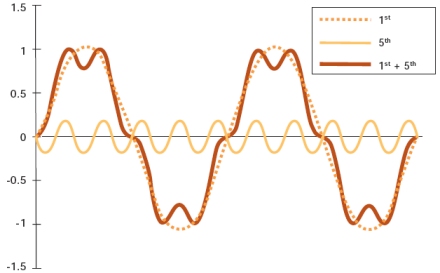Technical note
|

The total current as the sum of the fundamental and 5th harmonic.
What are harmonics?
Harmonic distortion is a form of electrical pollution that can cause problems if the sum of the harmonic currents increases above certain limits. A harmonic current is one with a frequency at a multiple of the fundamental frequency, for instance a 250 Hz current on a 50 Hz network is the 5th harmonic. The 250 Hz current represents energy that cannot be used by devices on the network. It will therefore convert to heat.
According the International Electrotechnical Commission (IEC), the level of harmonics is described by the total harmonic distortion (THD) and is expressed as a percentage of the total voltage or current. In the standard IEEE 519 it is refered to as total demand distortion (TDD).
What is the effect of harmonics?
Harmonics may cause cables to overheat, damaging their insulation. Motors may also overheat or become noisy and torque oscillations in the rotor can lead to mechanical resonance and vibration. Capacitors overheat with, in the most severe cases, the risk of explosion as the dielectric breaks down. Electronic displays and lighting may flicker, circuit breakers can trip, computers fail and meters give false readings.
How are harmonic currents created?
Harmonic currents and voltages are created by non-linear loads connected on the power distribution system. All power electronic converters used in different types of electronic systems can increase harmonic disturbances by injecting harmonic currents directly into the supply network. Common non-linear loads include motor starters, variable speed drives, computers and other electronic devices such as electronic
lighting, welding supplies and uninterruptible power supplies.
How can the effect of variable speed drives be reduced?
Harmonics can be reduced by modifications to the supply network, drive system and by using external filtering. The current harmonics depend on the drive construction and load.
Factors that increase current harmonics include:
- No network choke
- Higher motor load
Factors that decrease current harmonics include:
- Greater DC or AC inductance
- Higher number of pulses in the rectifier
- Active rectifier
Factors that decrease voltage harmonics caused by the harmonic currents:
- Larger transformer
- Lower transformer impedance
- Higher short circuit capacity of supply
Using 6-pulse, 12-pulse, 18-pulse or 24-pulse rectifier
The most common rectifier circuit in three-phase PWM-drives is the six-pulse diode rectifier. This rectifier is rugged, robust and cheap, but the input current contains high amounts of low order harmonics. The twelve-pulse rectifier is formed by connecting two six-pulse rectifiers in parallel to feed the same DC bus. These rectifiers are fed through a special transformer with two secondaries. This gives a smoother current waveform than the single six-pulse rectifier. The 18-pulse and 24-pulse rectifiers are formed similarly by connecting three or four sixpulse rectifiers. The drawbacks are the special transformer and complicated cabling which add to the cost of the
installation.
Using an active IGBT rectifier
An active IGBT (insulated gate bipolar transistor) rectifier can be used to control the power from the supply network. This allows the power factor to be maintained close to unity as the rectifier is actively modulated to reduce harmonic overtones.
The main benefits are:
- Nearly sinusoidal supply current with low harmonic content
- Unity power factor
- Voltage boost capability. Should the supply voltage fall, the
DC voltage can be boosted to keep the motor voltage at required level - Possibility to generate reactive power
The main drawback is the higher cost when compared to the
diode rectifier.
Using large DC or AC choke
DC and AC chokes are solutions that protect the motor and decrease current leakages caused by a long motor cable. A variable frequency drive with a large DC or AC choke offers a reduced harmonic current distortion but the actual result varies a lot depending on the type of choke used.
The main drawbacks of using a large choke are the size and cost. An AC choke has also a voltage drop that impacts the system.
External active filter
The active filter compensates the harmonics generated by nonlinear loads by generating the same harmonic components in the opposite phase. External active filters are most suited to multiple small drives.
Cost evaluation
Many solutions exist to mitigate harmonic distortion. When considering the best fit for an application, one should remember that the total cost of the system will consist of
not only the variable frequency drive´s price but also the installation, maintenance, footprint and hauling costs. The physical footprint of the solution should also be taken into account as it can vary from one to triple depending on the solution.
For more in-depth information about harmonics, refer to Technical Guide no. 6 “Guide to harmonics with AC drives“ reference 3AFE64292714.

Overview of the overall footprint of different harmonic reduction solutions.
For more information please contact:
www.abb.com/drives
www.abb.com/drivespartners
© Copyright 2009 ABB. All rights reserved. Specifications subject to change without notice.


